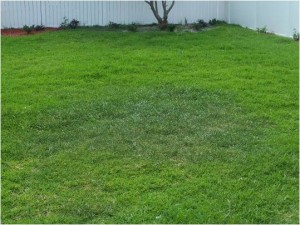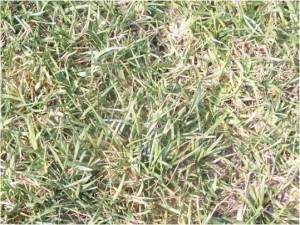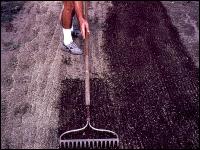
by Larry Williams | Apr 1, 2014
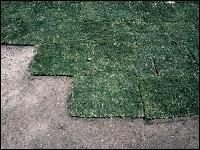
Sodding Lawn Photo Credit: UF/IFAS

Hand Raking Lawn Area Photo Credit: UF/IFAS
Cutting corners during lawn renovation usually results in poor turf establishment and long-term lawn maintenance problems.
Occasionally it is necessary to renovate a lawn or replant sections of a lawn. When replanting a lawn, it is best to not cut corners – you’ll usually pay for it in the long run. One of the most important factors is to prepare a good planting bed when renovating a lawn.
It doesn’t matter if you intend to re-sod, re-sprig or reseed; you need a level, loose and well-drained planting site for your lawn. A level lawn is much easier to mow. The loose soil allows for quicker root and runner establishment. Also, a well-drained site allows excess water to drain, preventing some disease problems.
One option is to spray the existing weeds and grass with a glyphosate herbicide such as Roundup. Allow the proper number of days for the weeds and grass to turn yellow (usually seven to 10 days).
Next, thoroughly till the area to a depth of 6 to 8 inches to loosen the soil.
Finally, level and smooth the planting bed, raking and then dragging (if needed) the bed. This can be done with a hand-rake and a hand-pulled drag such as a piece of chain-link fence on smaller areas. A tractor with rake and a grading box can be used on larger areas. A second option is to rent a sod cutter or remove the existing grass with a shovel before tilling and grading the site.
But whatever you do, don’t just lay new sod or broadcast grass seeds over a compacted, uneven, old lawn. There are just too many possibilities of having long-term and costly lawn problems as a result.
For additional information on establishing a Florida lawn, contact your local University of Florida Extension Office or visit http://hort.ufl.edu/yourfloridalawn.
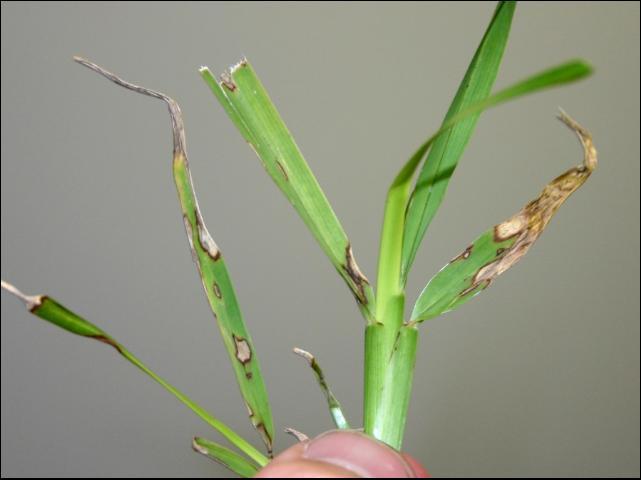
by Larry Williams | Jul 22, 2013
Gray Leaf Spot is a common fungal disease of St. Augustinegrass. Recent wet conditions have promoted this disease. This includes high humidity, heavy dews and particularly frequent afternoon and evening rains.
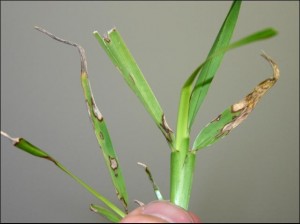
Gray leaf spot symptoms on St. Augustinegrass. Photo credit: UF/IFAS Extension
The individual spots or lesions are first seen as tiny brownish spots smaller than a pinhead. As they become larger, they will be circular and then begin to elongate lengthwise along the leaf. The spots will become brown to grayish in appearance. Numerous spots or lesions may be found on an individual leaf. Heavily infected leaves begin to turn brown and wither, usually beginning at the tip of the blade.
Gray leaf spot can move rapidly during prolonged warm, wet periods. Over watering or irrigating in the evening provides the prolonged period of wetness required for disease infection. For more information on how to correctly water a Florida lawn, visit the UF / IFAS Lawn Watering Website.
According to the Florida Lawn Handbook, “Severity of the disease is enhanced by application of readily available nitrogen fertilizer and is proportional to the amount of nitrogen applied.” Select fertilizers that are low in nitrogen or that have slow release nitrogen. Be careful to not overdo it in fertilizing your lawn and do not apply a high nitrogen fertilizer on top of an already infected lawn. Also, some lawn weed killers such as atrazine will increase the susceptibility of the grass to gray leaf spot.
Irrigate during early morning hours to minimize the period in which the grass is wet and water only on an as needed basis, watering less often but deeply. Avoid frequent, shallow watering and don’t irrigate when the lawn is already wet from rain. With the recent frequent rains, very little to no supplemental irrigation has been needed on most lawns in our area. Avoid leaving irrigation timers on when adequate rainfall has occurred. It’s best to operate irrigation controllers on manual so that the lawn can be monitored and irrigation provided during dry times.
If the disease outbreak is severe, fungicide may be needed. Look for products containing propiconazole, triadimefon or thiophanate-methyl. Always follow the product’s label directions and precautions.
For more information on maintaining a Florida lawn, contact your County UF/IFAS Extension Office or visit the YourFloridaLawn Website.

by Julie McConnell | Jul 22, 2013
 When you contact your local extension office for pest control recommendations you will likely hear “follow the label” over and over again. So, why do we emphasize the pesticide label so strongly when talking to both homeowners and landscape professionals?
When you contact your local extension office for pest control recommendations you will likely hear “follow the label” over and over again. So, why do we emphasize the pesticide label so strongly when talking to both homeowners and landscape professionals?
There are many important reasons why you should always read and follow label instructions.
- The Label is the Law – using a pesticide in a manner that is inconsistent with the label is a violation of the Federal Insecticide, Fungicide, and Rodenticide Act (FIFRA). Using a product inconsistent with the label includes, but is not limited to: rate of application, use on site not labeled for control, use on plants/lawns not labeled, frequency of application, method of application, distance from water sources, etc.
- Safety of Humans – using a product incorrectly can cause harm or even lead to death
- Safety to Non-target Organisms – this includes non-target insects, reptiles, birds, fish, mammals, and plants which can lead to negative impact on environment and economy
- Effectiveness of Product – millions of dollars are spent to figure out the most effective way a product works best, follow their instructions! (remember the manufacturer wants the product to be effective so that you’ll recommend to others and buy it again)
- Increased Resistance Decreases Control – improper application and a failure to rotate products as part of an integrated pest management program can increase likelihood of resistant pest populations
Before shopping for any pesticides, do some research:
- Has the pest been identified properly? What life cycle stage is the pest at? Most pesticides have different levels of efficacy depending on life cycle of target. For example, glyphosate works best on young plants that have not yet flowered. Your local extension office can help with identification and timing of control methods
- Can you control the pest with cultural practices such dethatching, irrigation, fertilizer, or mowing height changes? Start with the least toxic method of control and only work up if ineffective
- Read the label before you buy to be sure that it is labeled for your plant /lawn, target pest. The label will also tell you what equipment you’ll need to mix and apply and safety equipment. If product is not ready to use, be sure you can follow mixing and application procedures safely
- Are there particular environmental precautionary statements that are relevant to your site?
- How much do you need? Have you measured the area for treatment? Just as you don’t want to make multiple trips to the store, you also do not want a lot of excess chemicals on hand. They have to be stored or disposed of according to label instructions, too
For more information about pesticide labels read EDIS PI-34 Interpreting Pesticide Label Wording.
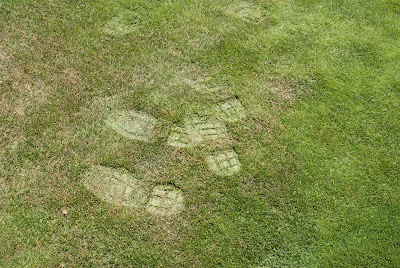
by Taylor Vandiver | Jul 15, 2013
Turfgrass, like all plants, requires water for growth and survival. With the weather we’ve been having lately, watering your lawn is probably the last thing on your mind.
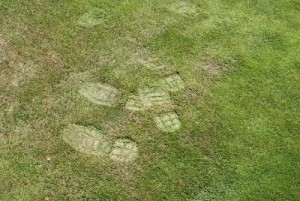
Footprints in turfgrass are a common symptom of drought stress. They are the result of a loss in turgor pressure, due to lack of water, in plant tissue.
However, without sufficient rainfall, water to home lawns will need to be supplemented with irrigation. The most efficient way to irrigate or water your lawn is to apply water only when the lawn starts to show signs of drought stress from lack of moisture.
A few signs associated with drought stress include the changing of turfgrass color from green to a bluish-gray, or white cast. Another sign could be “footprints” on the lawn. If walking across a lawn late in the afternoon causes footprints to be left behind, the lawn may need watering. When feet compress the leaf blades of the turfgrass, the low water levels in the plant tissue prevent the leaf blades from recovering, or “springing” back up, after being pushed down. If the footprints remain for an extended period of time, water the lawn to prevent the turfgrass from turning brown and becoming dormant. The visual condition of the turfgrass can also be used to evaluate drought stress. Turfgrass blades respond to drought stress by folding, rolling, and/or wilting.
A recommended application of ½ to ¾ inch of water can be applied when your turfgrass begins to show the drought stress symptoms discussed previously. Once this amount of water is applied, do not apply again until drought is noticeable. If it rains, like it has been lately, hold off on irrigating until visible drought stress symptoms appear.
Irrigation frequency can vary based on grass species, rainfall amounts, soil type and amount of compaction, shade presence, location, etc. There is a fine line between under and over watering a lawn. Over watering can cause problems such as poor root growth and susceptibility to disease. Over watering can also increase the presence of weed species. When watering, avoid applying water to the point of runoff. Allow the water to soak into the lawn and soil. The optimal time of day to water lawn grass is during the early morning hours. If irrigation is done during the day that water is being lost to higher evaporation rates. Watering in late afternoon or late morning may be detrimental if it extends the time the lawn is naturally wet from dew. This extended “dew period” may increase disease presence in turf.
Automated irrigation systems are convenient, but can have flaws. Always check to make sure your system is working properly and is applying the correct amount of water. However, if significant rainfall has fallen for the week, the automated timed irrigation systems can be turned off so water is not wasted.
Once turf has been watered, it should not be watered again until similar drought stress symptoms are observed. It is never suggested to water your lawn every day, unless it is in the establishment phase or renovations are occuring. Proper watering techniques are key to creating a happy and healthy lawn.








